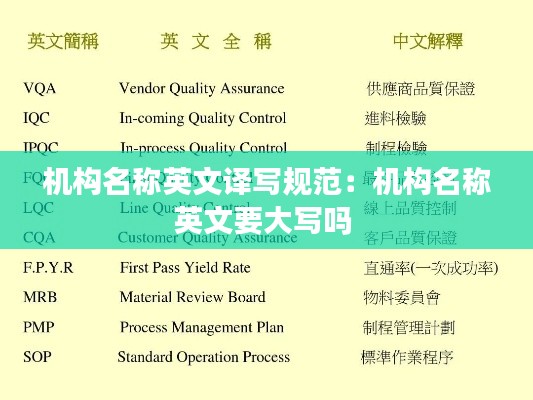Introduction to the Importance of Standardized Transcription
In the globalized world we live in today, effective communication is key to the success of any organization. One aspect of this communication is the accurate and consistent transcription of institutional names. Whether it is for official documents, international collaboration, or simply branding purposes, adhering to a standardized transcription of institutional names is crucial. This article aims to provide a comprehensive guide on the norms and best practices for the English translation and transcription of institutional names.
Understanding the Nature of Institutional Names
Institutional names are unique identifiers for organizations, encompassing a combination of words that represent the nature, purpose, and history of the institution. These names can be complex, with various elements such as prefixes, suffixes, abbreviations, and even special characters. The challenge lies in accurately translating and transcribing these names while preserving their original meaning and pronunciation.
Principles of Transcription
When transcribing institutional names into English, it is essential to follow certain principles to ensure clarity and consistency. Here are some key principles to consider:
Preservation of Original Meaning: The translation should convey the same meaning as the original name. This includes maintaining the intent and symbolism behind the name.
Consistency: The same name should be used consistently across all official documents and platforms to avoid confusion.
Clarity: The transcription should be clear and easy to understand, even for those who are not familiar with the original language.
Preservation of Pronunciation: Whenever possible, the transcription should reflect the pronunciation of the original name as closely as possible.
Best Practices for Transcription
Here are some best practices to follow when transcribing institutional names into English:
Use of Diacritics: If the original name includes diacritics (accents, tildes, etc.), consider whether they are significant in conveying meaning and include them in the English transcription if necessary.
Abbreviations and Acronyms: If the name is commonly abbreviated or referred to by an acronym in the original language, consider whether the same abbreviation or acronym is suitable in English.
Prefixes and Suffixes: Transcribe prefixes and suffixes according to their meaning and usage in English. For example, "Institute" might be translated as "Institut" in German, but "Institute" in English.
Capitalization: Use proper capitalization rules to ensure that the name is easily recognizable. Typically, the first letter of each significant word is capitalized, but this can vary depending on the specific style guide.
Hyphens and Spaces: Pay attention to the use of hyphens and spaces, as they can affect the pronunciation and meaning of the name.
Examples of Transcription
Let's look at a few examples to illustrate the principles and best practices:
Original Name: "Consejo Superior de Investigaciones Científicas" (Spanish)
English Transcription: "Higher Council for Scientific Research" or "Spanish National Research Council" (depending on the context)
Original Name: "Bundesamt für Umwelt" (German)
English Transcription: "Federal Environmental Agency" or "German Federal Environmental Agency" (depending on the context)
Original Name: "Académie des Sciences" (French)
English Transcription: "Academy of Sciences" (with no change in capitalization or abbreviation)
Adherence to Style Guides
It is important to note that different organizations and regions may have specific style guides for the transcription of institutional names. For instance, the United Nations uses the "Standard Transcription of Personal and Geographical Names into English" guide, while academic institutions may follow the Chicago Manual of Style or the MLA Handbook. Always refer to the relevant style guide when in doubt.
Conclusion
转载请注明来自南京贝贝鲜花礼品网,本文标题:《机构名称英文译写规范:机构名称英文要大写吗 》















 蜀ICP备2022005971号-1
蜀ICP备2022005971号-1
还没有评论,来说两句吧...